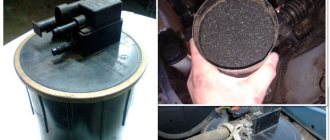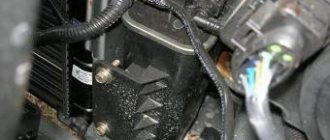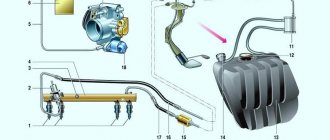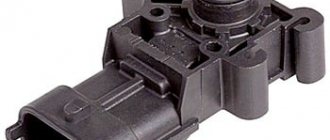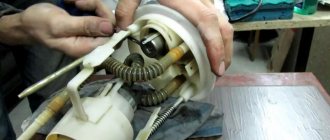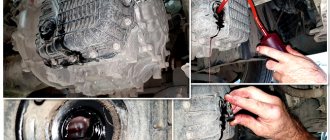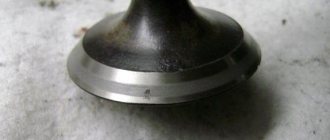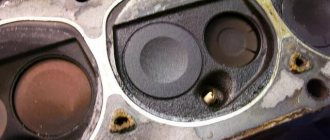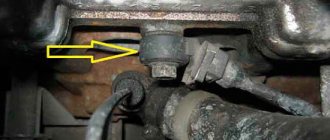Let's start with the fact that the automatic transmission solenoid is actually an electromagnetic valve-regulator. The main task is the timely opening and closing of the oil channel through which ATF is supplied under pressure.
It is important to understand that automatic transmission solenoids, like any other devices, have a limited service life, may malfunction or fail under certain conditions. Next, we will look at what solenoid malfunctions often occur, what to do in this situation and how to check the automatic transmission solenoids for functionality
What role do solenoids play?
In the automatic transmission valve body, transmission fluid under pressure acts on the clutch, ensuring smooth gear changes. This process is controlled using the car's on-board computer. The ECU supplies pulses through solenoid valves - solenoids installed on the hydraulic module in the automatic transmission. They consist of an electric coil running under direct current and a metal inner core.
Each solenoid performs a specific function:
- Turning channels on and off
- Adjusting the directions of ATF hydraulic flows at a given point in time.
- Control over the amount of liquid passing through the channels per unit of time.
Solenoids are responsible for the following processes:
- switching speeds;
- control of the torque converter unit (in common parlance - donut);
- functioning of the braking system.
Types of solenoids for automatic transmissions
Solenoid valves for automatic transmissions of earlier production were designed as an on-off type. They had a simplified design and were used to open and close channels passing the working fluid of the hydraulic system. New generation products - VOILVO solenoids with cores of a sophisticated design are equipped with a built-in ball-type metal valve. This invention has not gained popularity because they are difficult to implement and often break down.
The main types of modern solenoids are divided into the following groups:
Three-way solenoid valves
Three-channel automatic transmission solenoids are designed to regulate pressure in the hydraulic system and supply oil to moving units. Their design is characterized by increased durability and reliability. Retrofitted solenoid valves are manufactured as multi-channel solenoids (three to five channels) that can control multiple plate valves. Thanks to the simplified design, the reliability of the solenoids has increased significantly, and the service life of the hydraulic units as a whole has also noticeably increased.
Intelligent solenoids
Particularly popular among automakers are intelligent solenoids that can control all functions of a hydraulic valve system. Regulator solenoids operate on the principle of a valve. They don’t just work to “open/close the channel”, now the clearance increases or decreases by a given amount, which allows you to dose the amount of incoming lubricant. The degree of cross-sectional opening depends on the magnitude of the pulse current supplied from the central on-board computer to the magnetic core of the electric valve.
Variety of solenoids
To date, the following types have become famous:
- Electrical solenoids. They were first used by American car manufacturing plants. In the 80s, this device was a valve installed in a channel. Through it, with the help of an oil deposit, the liquid moved into the system. In this type of device, only two positions were provided: open and closed.
- Volvo solenoids were created by developers from Sweden. These mechanisms differed in their design features: they were equipped with a pushing core and a ball-shaped valve made of metal. Here it is necessary to explain what a core is. Essentially, this is a rod that fits onto the part. A valve with a core in the composition activates a channel designed to move oil. The finished mechanism was highly efficient, but did not become widespread. This was due to the complex structure of the model, as well as the fact that it broke down quite often.
- Three-channel solenoids make it possible to easily regulate the pressure in the mechanism and move the oily liquid to moving parts. The design was thought out with special care, and therefore the finished models are characterized by a high degree of reliability and long service life.
- Smart solenoids were developed in the 90s of the last century. They made it possible to effectively control the functioning of the hydraulic unit, and therefore at one time they were in high demand. Particularly popular were models that practiced the valve principle, in other words, they made it possible to open or close the channel, as well as slightly open it to control the volume of moving oil. The valve was controlled via a central computer. It was needed to transmit pulsed current to the core. The design has also undergone significant changes, mainly affecting the electric valves. This made it possible to create solenoids with multiple channels. At the same time, the design itself has become a little simpler.
Malfunctions of automatic transmission solenoids and their repair
During operation of an automatic transmission, error messages are sometimes displayed due to the failure of the solenoids. To avoid failures in automatic transmissions, it is recommended to carry out regular maintenance of both individual electromechanical valves and the entire unit.
To prevent the solenoid core from jamming, it is enough to wash the device in a special solvent. Solenoid blocks are cleaned using ultrasound. When using ultrasound, there is no need to remove the solenoids from the automatic transmission. This procedure is performed after a travel distance of 50,000 km.
Replacement or repair of automatic transmission solenoids is carried out after the car has driven more than 300,000 km, as well as after intensive use of the car. If the valve holes are worn out, noticeable leaks of lubricant and coolant appear, they must be replaced with new elements.
Reasons for failure of solenoids in automatic transmissions, diagnostic difficulties
Despite their durability and reliability, automatic transmission solenoids sometimes fail, become deformed, and break.
The most common causes of solenoid failures:
- Accumulation of harmful oil deposits on metal rods.
- Lack of response to electrical signals (the rod gets stuck and does not extend).
- Core jamming.
The use of cheap, low-quality transmission oil or failure to meet the deadlines for a complete service replacement of the lubricant leads to the final destruction of the functionality of the solenoids in automatic transmissions. Wear products included in the working fluids are gradually deposited on the surface of the magnetized rod.
Such a breakdown is difficult to detect during diagnosis. To avoid failures in transmission control, it is recommended to fill the crankcase with transmission oil of the appropriate quality, and also not to ignore the car manufacturers’ recommendations on regular replacement of lubricant.
Service companies carry out computer diagnostics of automatic transmissions, including solenoids. If necessary, unsuitable solenoid valves are replaced here with new mechanisms. Masters of specialized points can instruct in detail how to check the performance of solenoids.
Tip: if one of the valves is stuck, it is recommended to replace the entire solenoid block at the same time.
A guarantee of long-term use of solenoids in automatic transmissions is the use of high quality oil.
Description of typical solenoid failures
Most often, solenoid valves suffer from the use of low-quality lubricant. The solenoid elements are covered with a coating of coked oil. There comes a moment when the movable rod finally jams in one position.
If the core is stuck in one solenoid, this means that all the valves included in the hydraulic unit of the automatic transmission will also soon jam. In this case, it is recommended to change all automatic transmission solenoids at the same time. In this case, it is also necessary to completely replace the lubricant with high-quality oil. The brand of lubricant is selected in accordance with the recommendations of the car manufacturer as set out in the instructions for this vehicle.
Solenoid valves also break down due to malfunctions in the control unit itself, which sends electrical impulses to the solenoids. Such a problem can only be identified by conducting a thorough computer diagnostic of the car. A failed ECU control unit cannot be repaired; it is simply replaced with a new, expensive copy.
The declared service life of automatic transmission solenoids is also limited in time. Like any mechanism, valves do not operate indefinitely even when the necessary requirements are met. The average duration of their operation is approximately calculated for the number of cycles equal to 300 to 400 thousand. It is necessary to take into account that the service life of the solenoids is significantly influenced not so much by the total mileage of the car, but by the driving style of the car owner.
If the driver practices aggressive driving, often presses the gas pedal and actively changes gears, the automatic transmission magnetic valves will need to be changed much earlier than the stated service life.
Typical Solenoid Malfunctions
- Pollution. The greatest damage is caused by the adhesive layer of the clutches. The channels become clogged, the plungers jam. Abnormal operation of the solenoids can damage the entire automatic transmission. Therefore, the hydraulic unit must sometimes be cleaned and replaced as the clutches wear out, especially the torque converter clutch.
- Wear of the solenoid itself and its components. Well, they are not eternal and have their own resource. It is better to change them according to the regulations and not wait until the computer starts showing an error. The most reliable solenoids can last for 400,000 kilometers, but usually they need to be replaced at 100,000–200,000 kilometers.
Author: D. Spirin
Self-check and replacement of automatic transmission solenoids
The solenoids are constantly in an aggressive environment - transmission oil with small metal wear products of gears (chips, splinters, soot from brake clutches, etc.). The operating principle of the automatic transmission valve is that its core is constantly in a magnetic field. This magnet attracts metal fragments in the oil solution to the rod and winding of the coil.
If, while operating the vehicle, signs such as impacts and jolts in the area of the gearbox are noticed, the sensor light indicating an automatic transmission malfunction comes on, gear shifting is accompanied by sharp impacts and jerking, it is recommended to check the condition of the solenoids:
- Primary computer diagnostics of the valve body.
- If the computer has issued a conclusion that the solenoids are broken, these mechanisms are removed from the machine for further analysis.
- Using a tester, the resistance of the solenoid is measured. This indicator should be 10-25 Ohms.
- Possible jamming of the core is checked. The valve contacts are connected to a power source with a voltage of 12 volts. If the solenoid is working properly, it should make an audible click when connected.
There is a method for checking solenoids using compressed air. It is believed that when the valve is purged in the closed position, it allows air flow to pass freely. Accordingly, in the open air does not pass through.
Replacing solenoids in an automatic transmission can be done in a garage. The main condition is careful implementation of the recommendations. The type of solenoid is determined based on the design features of the automatic transmission. The necessary technical data for the automatic transmission can be found in the operating instructions for the specific vehicle.
How to check an automatic transmission solenoid: what to look for
Let's start with the fact that the automatic transmission solenoid is actually an electromagnetic valve-regulator. The main task is the timely opening and closing of the oil channel through which ATF is supplied under pressure.
It is important to understand that automatic transmission solenoids, like any other devices, have a limited service life, may malfunction or fail under certain conditions. Next, we will look at what solenoid malfunctions often occur, what to do in this situation and how to check the automatic transmission solenoids for functionality
Let's sum it up
As you can see, the solenoid is an important element in the automatic transmission design. In this case, failure of the specified valve body valves disrupts the operation of the entire automatic transmission. Often, the main problem is natural wear of the solenoids or their contamination.
Taking into account the fact that wear and tear during operation cannot be avoided, the only measure to increase service life is to control the cleanliness of the transmission fluid and regularly replace it along with the automatic transmission filters.
Also, in some cases, it is recommended to flush the valve body and/or automatic transmission before changing the oil if signs and symptoms of persistent contaminants and deposits are already noticeable.
Didn't find the information you are looking for? on our forum.
Solenoid: how to check and why this element fails
So, the operation of the automatic transmission solenoids is controlled by the automatic transmission ECU. The control unit constantly sends pulse signals of a certain frequency to the valve. In simple words, the solenoid actually controls the oil pressure, which, in turn, is the working fluid in the machine device.
- Simply put, a solenoid is a device where a metal rod is wrapped in a spiral through which direct current flows. The rod in the housing is movable when a current acts on the spiral, this causes the rod to move from the end of the spiral to its beginning.
Also in the device of such a solenoid (electrovalve) there is a spring, which forcefully returns the rod to a given position. Without going into too much detail, the job of the solenoid is to close or open a passage for transmission oil.
The solenoids are located in the valve body (hydraulic valve plate, automatic transmission valve block) and are inserted into the channel, secured with a bolt and a pressure spring. Also connected to the solenoid is a cable or wiring connector for connection to the control unit (automatic transmission ECU).
- Please note that often problems in automatic transmission operation are associated with wiring failure, that is, the ECU simply loses connection with the valve and the automatic transmission cannot operate normally. It is also not uncommon for the solenoid itself to fail. When checking, it is important to consider what type of device is used on a particular automatic transmission, since there are several types of solenoids.
Types of gearbox solenoids - automatic
If the first solenoids worked on the “open/close” principle, then the device later evolved, turning into a hydraulic valve. In short, control solenoids can be ball and spool (they have a valve - a spool).
The solenoid has a separate oil passage and a ball valve to open and close this additional passage. Subsequent improvement of the design made it possible to create several channels, which are separately closed by ball valves.
It is also possible to highlight the differences in solenoids both in design and purpose. For example, linear (proportional) ones, which allow you to change individual solenoids without replacing the entire valve body. The VFS (Variable Force Solenoid) type is simple in design, but more complex to control and has a shorter lifespan than its linear counterparts.
According to their functional purpose, EPC solenoids are distinguished (LPC, Line Pressure Control, line pressure valve). This is the “main” valve that distributes the fluid to the remaining channels. There is also a TCC valve, as it is responsible for locking the torque converter clutch.
By the way, this solenoid is the first to fail in many automatic transmissions, since heated and contaminated oil from the gas turbine engine enters through it. You can also note the shift solenoid (switch). The element is responsible for engaging “up” and “down” gears, etc.
PWM, VFS and "proportional"
In the nineties, the design of solenoids became even more complex. Now the solenoids were required not only to open and close the oil flow, but also to provide smooth pressure control.
The operation of these solenoids became similar to the operation of a valve, rather than a faucet. Now there were not two provisions, but many. Depending on the command of the electronic control unit, they are able to smoothly open or close the channel, according to the calculated curve.
Instead of plungers, balls or spools are now used, 4Way and 5Way appear.
Proportional solenoid
Toyota's transmission subsidiary, Aisin, creates its own solenoid design, which it calls “ proportional.”
This much more complex and technologically advanced device now includes ports that were previously part of the hydraulic valve plate and are controlled by a spool plunger to open or close them. The channels, which were previously located inside the hydraulic plate and were actively worn out by abrasive treatment with metal particles and debris in the oil, have now become part of the solenoid. If they wear out, there is no need to replace or restore the entire valve body - just change the solenoid itself. The service life of the hydraulic plate has increased significantly, and the most obvious problem of all modern automatic transmissions has been solved. The “proportional solenoids” themselves, of course, do not last very long, but they are also consumables - their replacement is very simple, you can do it yourself, and they are quite inexpensive in comparison with the valve plate. After 5–6 years, it is necessary to check their performance.
In modern automatic transmissions, these solenoids are also adjacent to conventional, “open-closed” types, but proportional ones do almost all the work, providing control of 4-5 oil flows each.
VFS or electric ball valves are widely used by ZF. They have a simpler and cheaper design. Instead of difficult-to-manufacture elements, here the role of a valve is played by a small steel ball.
VFS solenoid automatic transmission
However, controlling such simple elements requires a very complex control system. The electronic control unit requires very precise feedback and is forced to constantly adapt to increasing pressure losses due to gradual wear of the valve. Fine tuning and constantly changing parameters make the operation of such an automatic transmission very capricious. The service life of these solenoids rarely exceeds five years; it is better to check them after 2–3 years of operation.
PWM Made from stronger and more reliable materials, they are more expensive. Trying to make them more reliable is the solution to the biggest problem with modern automatic transmissions. When opening and closing the flow in the operation of the solenoid, at some points in time a very small gap inevitably formed, through which oil filled with debris and metal particles rushed at great speed. With a large cross-section, debris could easily walk inside the oil flows and be pushed away from the walls of the channel, but when it was reduced, large pieces of debris were literally dragged under pressure along its walls. Which led to its wear and tear. In PWM solenoids, the weakest points have been strengthened.
PWM solenoid
If earlier automatic transmission designs were simpler, more reliable and could run on liquids that hardly resembled oil, now modern automatic transmissions are much more “gentle.” Previously, hydraulic blocks were made of cast iron, but now they are made of soft, lightweight aluminum. Due to attempts to squeeze out maximum efficiency, reduce losses on the torque converter, reduce fuel consumption, increase the dynamics and comfort of the car, all automatic transmission mechanisms began to work much more accurately and loaded. Which inevitably led to increased wear of all gearbox mechanisms and rapid contamination of the oil with their remains. The filter elements have also been modernized, but they are not perfect. If in a modern automatic transmission you do not change the oil as it becomes dirty, it acquires the properties of sandpaper, which is constantly driven through all the insides of the machine at high speed. And this makes him feel completely unwell.
How to check automatic transmission solenoids and replace them
The appearance of jerks, kicks, slipping of the automatic transmission, delays during switching, the absence of any gears, or harsher operation of the automatic transmission may indicate that the solenoids are malfunctioning or are partially/completely out of order.
The presence of chips on the dipstick or in the pan, severe contamination of the ATP oil, and its cloudiness are also additional signs of problems with the valve body valves.
To understand which solenoid is not working, you need to take into account the design features of a particular automatic transmission. If solenoids are responsible for speed and torque converter control, then, for example, there are 4 solenoids in a 4-speed gearbox.
Also, when there are shocks from the automatic transmission and jerks from the automatic transmission, the A/T light often lights up on the panel, which indicates problems in the transmission. In such a situation, you need to check the valve body.
The solenoids themselves are checked for resistance. To do this, 12V voltage must be supplied to the valve. If the solenoid remains operational, the valve makes a characteristic click.
If there is no click, this means that contamination or damage has occurred. To begin with, you can blow out the valve with pressurized air while simultaneously applying voltage to it. Normally, air should flow through the element.
Then you need to check the solenoid and, if the result is satisfactory, install it in place. However, the problem often lies in the fact that many automatic transmissions today have non-separable valves.
It turns out that if air and purifiers do not help, and the ultrasonic bath does not produce results, the device only needs to be changed. Replacing the automatic transmission solenoid itself is quite simple. The main thing is to remove the valve body, disconnect the solenoid and remove it from the valve plate. Afterwards, the new element is installed in place and assembly is carried out in the reverse order.
Second generation of solenoids
Unlike the previous mechanism, the solenoid-electric valve has an oil channel with an inlet and an outlet and is essentially a hydraulic valve. The locking and unlocking of the oil flow in this solenoid is carried out by a ball valve made of metal. Despite the fact that this type of solenoids is more complex, its design is much more reliable. In addition, this type of solenoids is much easier to change; to do this, you just need to disconnect the connector and pull out the o-ring, due to which the solenoid holds pressure. The solenoid-electric valve, like electrical contacts, can be normally closed or normally open. This means that in its initial state such a solenoid is either open or closed, and under the influence of electric current it will return to the opposite position. While no current is supplied to the solenoid, it returns to its original position under the action of the return spring. When electric current is applied, the magnetic field generated by the winding will push the plunger in the opposite direction with a force sufficient to overcome the resistance of the return spring. In modern automatic transmissions, small metal filters are located in the solenoid channels, in the form of a mesh, which stop debris and prevent the solenoid or its channel from becoming dirty.
Second generation solenoids
